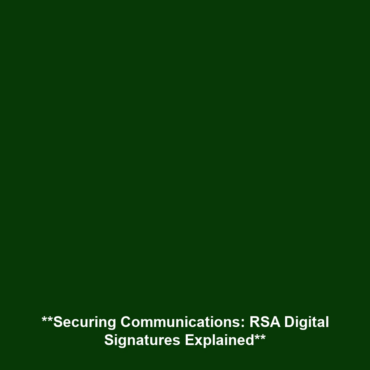RSA for Digital Signatures: Securing Documents and Communications
Introduction
In the rapidly evolving field of cryptography, the RSA algorithm plays a critical role in ensuring the integrity and authenticity of digital communications. By leveraging the power of RSA, individuals and organizations can create and verify digital signatures, which are widely adopted in securing documents and communications across various platforms. Understanding the functionality and significance of RSA for digital signatures not only underscores its impact in cyber security but also highlights its broader implications in protecting sensitive information from unauthorized access.
Key Concepts
To grasp the significance of RSA in the digital signature landscape, it’s essential to understand several core concepts:
- Public Key Cryptography: RSA is a type of public key cryptography that utilizes a pair of keys—one public and one private—for creating secure communications.
- Hash Functions: The RSA algorithm employs hash functions to create a unique signature for a document, enabling easy verification.
- Digital Signatures: By signing a document with a private key, the sender can ensure that the recipient can verify it with the corresponding public key, thus authenticating the source and integrity of the data.
Applications and Real-World Uses
RSA for digital signatures has a multitude of real-world applications, significantly enhancing the realm of cryptography. Some notable uses include:
- Secure Email: RSA is widely used in secure email protocols (like S/MIME) to authenticate email senders and ensure message integrity.
- Online Transactions: E-commerce platforms employ RSA to secure payment processing systems, assuring customers of the authenticity of transactions.
- Software Distribution: Companies use RSA signatures to verify the integrity of downloaded software, preventing the risk of installing malicious programs.
Current Challenges
Despite its significant advantages, RSA for Digital Signatures faces several challenges:
- Computational Complexity: The encryption and decryption processes can be resource-intensive, requiring significant computational power.
- Key Management: Maintaining the security of private keys is crucial; any compromise can lead to severe security breaches.
- Quantum Computing Threats: The advent of quantum computing raises concerns about the potential for breaking RSA encryption, prompting the need for post-quantum cryptographic solutions.
Future Research and Innovations
The landscape of RSA and digital signatures is evolving with ongoing research focused on next-generation technologies. Key areas of exploration include:
- Post-Quantum Cryptography: Developing algorithms that can withstand the capabilities of quantum computers, ensuring long-term security.
- Blockchain Integration: Utilizing RSA combinations with blockchain technology to enhance the security of distributed ledger systems.
- Improved Key Management Solutions: Seeking innovative methods for the secure storage and management of cryptographic keys.
Conclusion
RSA for digital signatures remains a cornerstone of modern cryptography, empowering users to secure crucial communications and documents effectively. As challenges emerge, enhancing this technology through research and innovation will be essential in maintaining its relevance. For further insights into digital security, explore our additional resources on cryptography basics and future cybersecurity trends.
